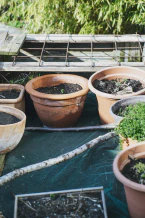Unlocking Drought-Resistance: Resurrection Plants Secret

Resurrection Plants: Nature’s Secret to Drought-Tolerant Crops
I’ve been fascinated by resurrection plants for over two decades now. These seemingly dead plants can lose up to 95% of their cellular water and remain in a dry, dead-like state for months to years, only to resurrect and start growing again when given water.
It’s a rare and impressive phenomenon, and it got me thinking: could we use this to create drought-tolerant crops? With the world’s population estimated to reach between 9 and 10 billion by 2050, food security is a growing concern. The Food and Agricultural Organizations of the world suggest we need a 70% increase in current agricultural practices to meet the demand. And that’s not even taking into consideration the potential effects of climate change.
Many areas that have been successfully used for agriculture are now unable to support crops due to lack of rainfall. This is especially true in Africa, where most agriculture is rainfed. We need smart solutions, and drought-tolerant crops could be one of them.
The challenge, however, is that water is essential to life on this planet. All living organisms are comprised mostly of water, and the loss of even a small amount can result in death. While we can make behavioral changes to avoid this, plants are stuck in the ground and can only lose so much water before they die.
Plants have developed different strategies to cope with this, from succulents that hold onto their water at great cost, to trees and shrubs that send down deep roots to access underground water supplies. Annuals, which make up the bulk of our plant food supplies, grow only in the rainy season and produce desiccation-tolerant seeds that can survive in extreme environments until the next rainy season.
Resurrection plants, however, take this to the extreme. They can dry out without dying and then resurrect when given water. My research has focused on understanding how they do this, from the molecular to the whole-plant level. We’ve discovered that there’s considerable similarity in the mechanism of desiccation tolerance in both seeds and resurrection plants, which means we may be able to use the same genes in crops to make them drought-tolerant.
It’s an ambitious approach, and we’re just getting started. But if we can repeat what nature did in the evolution of resurrection plants, we may be able to create crops that can survive in the face of drought and help secure food for our growing population.
Understanding Resurrection Plants: How They Survive Drought
If you’re a farmer, you know how important it is to have crops that can withstand dry spells. Drought-tolerant plants are a godsend, as they can thrive even when water is scarce. But have you ever wondered how some plants are able to survive for months or even years without any water at all? The secret lies in resurrection plants.
Resurrection plants are a special type of plant that can survive extreme dehydration. When the plant is exposed to drought, it loses water rapidly and shrivels up, appearing to be dead. However, when water becomes available again, the plant “resurrects” and becomes fully functional once more. These plants have developed mechanisms that allow them to survive in harsh, arid environments.
Researchers have been studying resurrection plants to better understand their unique abilities. One of the things they have discovered is that these plants have a special sugar called trehalose that helps protect their cells from damage during dehydration. This sugar acts as a protective shield, preventing the cells from collapsing or becoming damaged when water is scarce.
Scientists are now working on developing drought-tolerant crops that can utilize these same mechanisms to survive dry spells. By introducing the genes responsible for trehalose production into crops like corn and wheat, researchers hope to create plants that can withstand long periods of drought without sacrificing yield.
The potential benefits of these crops are enormous. In areas where water is scarce, farmers could grow crops that are more resilient to dry spells, reducing the risk of crop failure and ensuring a steady supply of food. Drought-tolerant crops could also help reduce the need for irrigation, conserving water resources and reducing the environmental impact of farming.
In conclusion, the secret to drought-tolerant crops lies in the fascinating world of resurrection plants. These plants have evolved unique mechanisms to survive in harsh environments, and scientists are now working to harness these mechanisms to create more resilient crops. With the help of resurrection plants, we may be able to develop a more sustainable and food-secure future.
Harnessing the Power of Resurrection Plants for Drought-Tolerant Crops
When it comes to agriculture, drought is a major problem for farmers. With climate change causing more frequent and severe droughts, finding ways to grow crops that can survive without water is becoming increasingly important. This is where resurrection plants come in.
Resurrection plants are a unique type of plant that can survive extreme dehydration and then come back to life when water becomes available again. These plants have evolved over time to cope with drought and extreme temperatures, and researchers have been studying them to find out how they can be used to develop more drought-tolerant crops.
One of the ways resurrection plants survive drought is by changing the way their cells function. When they dry out, their cells are filled with sugar, which acts as a natural antifreeze, protecting them from damage. The plants also produce protective proteins that help prevent cell damage and preserve their membranes.
By understanding how resurrection plants survive drought, scientists hope to create crops that are more resilient to dry conditions. They are looking at ways to incorporate the genes and proteins found in resurrection plants into crops such as rice, maize, and wheat, which are major sources of food worldwide.
Not only would drought-tolerant crops help farmers grow more food in dry regions, but they could also reduce the amount of water needed for irrigation. This would have significant benefits for the environment, as agriculture is one of the largest users of water globally.
In conclusion, the study of resurrection plants is providing valuable insights into how we can develop more drought-tolerant crops to sustainably feed our growing population. With climate change threatening our food security, it is more important than ever to find innovative solutions to the challenges facing agriculture.
Toughness in Drought: Lessons from Resurrection Plants
Droughts have always been a major challenge for farmers, leading to crop failure and economic losses. With climate change, droughts are becoming more frequent and severe, making it crucial to find ways to grow crops that can tolerate dry conditions. That’s where “resurrection plants” come in.
Resurrection plants are a group of plants that can survive extreme drought by going into a state of dormancy, where they can lose up to 95% of their water content without dying. They can remain in this state for months or even years until the next rain, at which point they can quickly recover and start growing again.
Scientists have been studying resurrection plants to understand how they are able to survive such extreme conditions, and they have discovered that these plants have unique mechanisms for regulating water loss and retention. By understanding and harnessing these mechanisms, researchers hope to develop crops that can also withstand drought and other environmental stressors.
One promising area of research is focused on genes that control the expression of proteins involved in water regulation. By identifying and manipulating these genes, scientists have been able to enhance drought tolerance in crops like rice and wheat. Other researchers are exploring the potential of using “hydrogels,” materials that can hold large amounts of water and slowly release it to plants, as a way to provide crops with water during dry periods.
Overall, the study of resurrection plants offers hope for the development of crops that can thrive in water-limited environments, helping to secure food supplies for a growing global population in the face of climate change.
Applying Resurrection Plant Mechanisms to Develop Drought-Tolerant Crops
Resurrection plants, a type of desert plant that can survive extreme dehydration and come back to life when rehydrated, have long been a fascination for scientists. And now, their unique ability to survive in harsh, arid environments is being studied to help create drought-tolerant crops.
The secret to the resurrection plant’s survival lies in its ability to switch into a dormant state when water is scarce. In this state, it sheds its leaves and slows down its metabolism to conserve water. Then, when rain finally arrives, the plant is able to quickly rehydrate and resume its growth.
Researchers are now exploring how to transfer this mechanism to crops, making them more resilient to drought and better equipped to survive in arid environments. By understanding the genetic makeup of resurrection plants, scientists hope to identify the specific genes responsible for their unique abilities and use this knowledge to create more resilient crops.
The potential impact of this research is significant. With climate change leading to more frequent and severe droughts, finding ways to create drought-tolerant crops is becoming increasingly important. By incorporating the genes responsible for the resurrection plant’s survival mechanisms, crops could become more resilient to water scarcity, helping to ensure food security in regions that are prone to droughts.
Overall, the study of resurrection plants offers a fascinating glimpse into the ways in which nature has adapted to survive in extreme conditions. By harnessing these adaptations, we may be able to create more resilient crops and help ensure a more sustainable future for us all.
Creating Drought-Tolerant Crops: Insights from Resurrection Plants
Resurrection plants may sound like something out of a sci-fi movie, but they’re real plants that have the ability to survive extreme drought conditions. These plants can be found in various parts of the world, including the deserts of Africa, Australia, and the Americas.
What makes resurrection plants so special is their ability to enter a state of dormancy during droughts. When water is scarce, they dry up and appear dead, but they can come back to life when water becomes available again. This unique ability has fascinated scientists for years, and they’ve been studying resurrection plants to understand how they can be used to create drought-tolerant crops.
One of the key ways that resurrection plants are being used to create drought-tolerant crops is through genetic engineering. Scientists have identified the genes responsible for the plant’s ability to enter a state of dormancy, and they’re working to incorporate those genes into crops. This would allow crops to survive extended periods of drought and ultimately produce more food with fewer resources.
In addition to genetic engineering, scientists are also studying the mechanisms behind the plant’s ability to conserve water. Resurrection plants have unique structures that allow them to store water and prevent dehydration during droughts. By understanding these mechanisms, scientists can design crops that are better able to conserve water and withstand drought conditions.
Overall, the research on resurrection plants and drought-tolerant crops is still in its early stages, but the potential benefits are enormous. With climate change and water scarcity becoming increasingly urgent issues, the ability to create crops that can survive and thrive in drought conditions is crucial for food security and sustainability.
The Future of Agriculture: Drought-Tolerant Crops Inspired by Resurrection Plants
Have you ever heard of resurrection plants? These are special types of plants that can survive extreme drought conditions by appearing dead and dry, but can revive and return to life when water is available. They’re fascinating organisms, and their unique survival mechanisms can teach us a lot about how to develop drought-tolerant crops.
Resurrection plants have the ability to protect themselves from water loss during periods of drought by curling up their leaves and shutting down photosynthesis. They also produce special proteins that protect their cells from damage caused by dehydration. When water is available again, they can quickly resume their metabolic activities and return to life.
Scientists are studying the unique features of resurrection plants to identify genes and proteins that could help create drought-tolerant crops. For example, by introducing genes that encode protective proteins into crops, we could help them survive droughts and produce more food with less water. This would be especially important in areas where water is scarce or where climate change is leading to more frequent and severe droughts.
Research on resurrection plants is still in its early stages, but the potential benefits are significant. By learning from these amazing plants, we can develop new ways to address one of the biggest challenges facing agriculture and food security today: drought.
Resurrection Plants as a Key to Drought-Resilient Crops
Farmers face numerous challenges when it comes to growing crops, and one of the most significant of these is water scarcity. With climate change causing increasingly frequent and severe droughts, it’s becoming more important than ever to find ways to grow crops with less water. That’s where resurrection plants come in.
Resurrection plants are a type of plant that can survive long periods of drought by going into a state of suspended animation. They can lose up to 95% of their water content and then recover when water becomes available again. This remarkable ability is thanks to a unique set of proteins and sugars that protect the plant’s cells from damage.
Scientists have discovered that these same proteins and sugars could be used to create crops that are more drought-tolerant. By introducing these genes into the DNA of crop plants, researchers hope to create crops that can survive longer periods without water, reducing the need for irrigation and improving yields in areas where water is scarce.
The potential benefits of drought-tolerant crops are enormous. Not only could they help farmers grow more food in dry areas, but they could also reduce the amount of water needed for agriculture, leaving more water available for drinking and other uses. Additionally, they could help lessen the effects of climate change by reducing the amount of water needed for farming and therefore reducing greenhouse gas emissions.
While research is still ongoing, the prospects for drought-tolerant crops are exciting. By drawing on the amazing abilities of resurrection plants, scientists and farmers could be on the cusp of a revolution in agriculture that could help feed the world’s growing population while preserving our precious water resources.
Conclusion
In conclusion, resurrection plants have been found to hold the key to developing drought-tolerant crops, which are crucial for sustainable agriculture and food security in many parts of the world. With the world population projected to reach 9.7 billion by 2050, it is essential to find ways to increase crop yields while minimizing water usage. The research on resurrection plants has opened up exciting new possibilities for plant biologists to develop crops that can withstand long periods of drought and other harsh environmental conditions. By studying the unique mechanisms of resurrection plants, scientists hope to gain insights into how to improve crop toughness and productivity. This could have a significant impact on the ability of farmers to grow crops in regions affected by drought and other extreme weather conditions, helping to feed the world’s growing population sustainably. Overall, the potential of resurrection plants in agricultural research is an exciting area to watch as we strive towards a more sustainable future.















